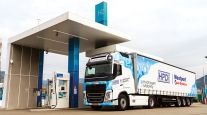LNG Supporters Eye Expansion to Create National Network
This story appears in the April 18 print edition of Transport Topics.
The first extended network of natural gas filling stations could be running in a few years, the head of the nation’s largest natural-gas fuel distributor said April 13.
That would be the first step in making natural gas available at locations where over-the-road truckers could fill their rigs. Today, scant availability is stymieing the fuel’s commercial credibility as a diesel alternative.
But in “about two to three years,” Clean Energy Fuels Corp. could have a network of “165 to 200 filling stations” up and running along major U.S. highways, said CEO Andrew Littlefair.
Clean Energy already has secured the capital to build the network, and “we’re going to go and spend the money,” he said.
Pumps would dispense liquefied natural gas, the form of the fuel best suited for heavy trucking, he said. These fuel islands would mostly be installed at Pilot Flying J truck stops along interstates such as 10, 40, 70 and 95, Littlefair said.
The network could support about 80,000 heavy-duty LNG trucks — almost 100 times more than are in service today, according to Clean Energy.
Littlefair spoke with Transport Topics on the same day lawmakers, truck makers and fleets congregated in Washington, D.C., to promote natural gas and gain support for a recently proposed package of federal tax breaks for natural-gas equipment.
Those incentives are part of a bill introduced April 6 by Rep. John Sullivan (R-Okla.) and co-sponsored by legislators on both sides of the aisle.
Several truck makers offer LNG-powered tractors.
Cummins Inc., through a joint venture with Canada’s Westport Innovations, builds heavy-duty natural-gas engines, and is the biggest player in the market. Navistar Inc. is planning to offer natural-gas engines for both medium- and heavy-duty trucks. Navistar’s biggest alternative truck engine will be a diesel/natural gas hybrid.
LNG is sold for the equivalent of about $2 a gallon, according to Clean Energy. The cheaper fuel offsets the higher purchase price of a new LNG truck, which is about $30,000 more than a new diesel.
Meanwhile, fleets that have recently bought LNG trucks lauded Sullivan’s bill, but told TT there are still not enough filling stations to drive widespread adoption.
“Infrastructure for fuel is the biggest limiting factor,” said Scott Perry, group director of vehicle supply management for Ryder System.
Ryder recently ordered 202 heavy-duty natural gas trucks to deploy in southern California. The vehicles will be part of a natural-gas leasing fleet, which Ryder believes will appeal to regional and local haulers, Perry said.
Ryder also is building two LNG filling stations. Perry said this is necessary because even in California, home to most of the nation’s LNG stations, availability is spotty outside certain municipalities.
According to the Department of Energy, there are 35 LNG filling stations in California, the majority of which are not open to the public. Texas had the next highest number of LNG stations with five.
According to Natural Gas Vehicles for America, there are about 1,000 U.S. filling stations that provide natural gas. About half are open to the public, but most offer compressed natural gas.
As for the rest of the country, “you can’t go from [Los Angeles] to New York on LNG,” Perry said. Ryder has some California customers that use natural gas trucks to make trips to Las Vegas or Phoenix, but fuel scarcity makes longer trips impossible.
Clean Energy estimates there will be about 74,000 heavy-duty natural gas trucks on U.S. roads by 2014. The company expects trucks powered by LNG to make up 15% of all new truck sales that year. By 2017, heavy-duty LNG trucks will account for 30% of all new truck sales, and there will be about 363,000 of them in service.
“It’s not going to take decades,” Littlefair told TT. “If it does take decades, then I’m fired.”
Perry’s timeline for widespread LNG availability is longer than Clean Energy’s. Perry thinks it will take “decades.”
Another fleet also ended up in the fueling-station business when it added LNG tractors to its fleet.
Dillon Transport, a Burr Ridge, Ill., tank and bulk hauler, this year bought 14 LNG trucks to use in dedicated service for a big chemical shipper. As part of the procurement, Dillon set aside some property near Dallas for Clean Energy to build an LNG station.
As for the trucks, “we’re committed to buying more of them,” said Charles Musgrove, Dillon’s vice president of operations. However, “one of the issues is getting the fueling infrastructure in place.”
Meanwhile, American Trucking Associations said that tax breaks on natural gas trucks are helpful but unlikely to lead to widespread conversion.
“We believe natural gas is an appropriate alternative fuel for [some] segments of our industry,” but “we don’t believe that there’s one fuel that will be a replacement for diesel in all segments of our industry,” said Rich Moskowitz, ATA vice president and regulatory affairs counsel.




